A blog in which Kay G. Radley gushes about games that he likes.
Don't wanna be here? Send us removal request.
Text
Favorite Game Over Screens (Part 2)
Continued from Part 1
(Spoiler Warning)
Capcom Beat-em-ups: Continue or Die!
youtube
For most games, a Game Over implies your death. You saw your character fall for the last time, and they aren’t getting back up. They could if you have a continue, but few show the consequences of not persevering quite like Capcom’s beat-em-up games from the 80s and 90s.
Final Fight is a pioneer in this. If you lose your last life, you see your hero strapped to a chair, trying desperately to blow out the fuse on some dynamite. Choose to continue, and a knife will drop in from above and cut the fuse. Call it quits, and...well, let’s say that Metro City is probably gonna need a new mayor. Sequels in the series also have you contend with flooding chambers and crushing beds of spikes.
It wasn’t just Final Fight, either: other brawlers Capcom made had their own takes on this theme, including trying to revive Frank Castle before he flatlines in The Punisher, your mech getting shot to pieces in Armored Warriors, or being threatened at gunpoint in Cadillacs and Dinosaurs. No matter the game, Capcom was keen on motivating you to put just one more quarter into the machine.
Road Rash series: Busted and Wrecked
youtube
The Road Rash series of motorcycle racing/fighting games is one near-and-dear to my heart, being one of the first Genesis games I played that wasn’t a Sonic game. When I first played it as a wee 4-year-old, I was terrible at it, so I quickly became familiar with its failure cutscenes.
Just from the second game alone, the many ways in which you are shown your failures makes the sting of failing to finish a race a little less painful, whether its having the EMTs abscond with your wrecked ride, or trying to hijack the paddy-wagon and getting stopped by a police cruiser only a few feet away.
The inclusion of these cutscenes is pretty impressive for early 90s Genesis games, and helped to make these failure screens memorable.
Mass Effect 2: Death by the Kirk Maneuver
youtube
Mass Effect got a lot of negative press attention for the inclusion of sex scenes, some of which even featured people who were...dare I even say it...of the same gender! GASP! I’d clutch my pearls if I wore them to start with!
In truth, despite what Fox News would have you believe, these sex scenes were fairly tame and brief, no different than a PG-13 movie. For the purpose of this article, they were also safe. One possible romance option in the sequel, much less so.
In Mass Effect 2, one of the people you can recruit to your team is Samara, an almost millennium-old asari warrior. Shortly after she joins you, you learn that she is hunting a particular serial killer: her own daughter, Morinth, who suffers from a genetic defect wherein anyone she tries to mate with via sexy mind meld has their brains scrambled like an egg.
If you fulfill certain conditions, you can turn on Samara and have Morinth join you in her stead. Then, after you beat the final mission of the game’s story, you can consummate with Morinth, but...well...what part of “scrambled like an egg” did you not understand?
They don’t make brain trojans in space, it seems.
Marvel vs. Capcom 3: Bon appetit!
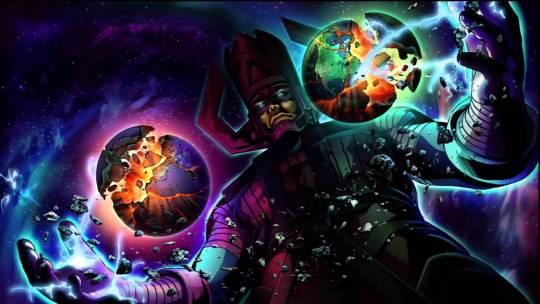
Final bosses don’t get much more memorable than Galactus, the planet-eating nemesis of the Fantastic 4 from Marvel vs. Capcom 3. Mostly because he was a big pain in the ass: while not nearly as cheap as bosses from SNK fighters, Galactus will make you work hard for your victory, and will make the consequences of your failure painfully obvious.
When you lose to Galactus, you’re treated to a brief cutscene of him glowering over the Earth, now red and cracked, before crushing it and feeding off of its life force. At this point, you can still continue and take another whack at the big lug, but if you decide to stop, you’ll be treated to a special ending where Galactus is eating not one, but two Earths, one for Marvel and one for Capcom.
On the other hand, if you’re playing Galactus Mode in Ultimate MvC3, this counts as a good ending!
NieR Automata: A flavor to die for.
youtube
NieR Automata (Which I’ve already written about and described as one of the most important games I’ve ever played) has twenty-six endings, but only the first five are actual endings. The rest can technically be considered endings since you see the credits scroll (really fast and for only a second), but are more like Game Overs in function, and are earned by doing things you really ought not do, like kill plot-important characters, run from key battles, or uninstall your character’s own OS chip.
One that stands out for me is also the first one I wound up getting. At one point, you get a fish from a character named Jackass, which she says is a mackerel. She wants you to eat it, so she can see how it affects androids.
You’re not actually supposed to eat the mackerel, because they cause the fluids in an android’s body to congeal and essentially kill them in a similar manner to pufferfish for humans. This is but one of a handful of ways the game dangles out little temptations to get you to die in an embarrassing manner and end the game.
At least the mackerel was tasty.
S.O.S.: Going down with the ship
youtube
There weren’t many games like S.O.S., but its influence helped to pave the way for games like Dead Rising, taking the player with rescuing as many people as possible in a short time limit and getting to the end alive.
A full game of S.O.S. only lasts about one hour in real-time. That how long you have to escape from a capsized and sinking ship, rescuing people you meet along the way. You don’t die from taking bad falls or hitting dangers, but you do lose time.
If you run out of time and are still conscious, you get to watch in horror as the ship finally goes under and the interior becomes flooded. No escape, no hope, all there is left for you to do is wait until you drown and are greeted by a very eerie Game Over screen.
It is haunting in its simplicity, and the feeling of helplessness you suffer as you are left to control your character in the last few minutes of their life.
1 note
·
View note
Text
Favorite Game Over Screens (Part 1)
youtube
(Obligatory spoiler warning, just as a precaution.)
It sucks losing at video games, and being greeted with those two dreaded four-letter words: “Game Over”. At least, most of the time. Sometimes, the result of your failure is fun to watch in and of itself. Sometimes, the manner in which you fail, while not very enjoyable, is memorable. Either way, they deserve their due.
So, without further ado, and in no particular order, here’s my list of some of my favorite Game Overs.
Friday the 13th (NES): The Dreaded “D” Word
youtube
Nintendo of America, back in the 80s through mid-90s, would have you believe that no one dies in video games. Destroyed, maybe. Defeated, most likely. But died? Heaven forbid! You didn’t kill Bowser by dropping him into a pit of lava in Super Mario Bros., you just defeated him! You didn’t kill Ganon in Legend of Zelda, you just destroyed him!
This presents a bit of difficulty with games based on ultraviolent films that are questionably marketed to children, but most of them found a workaround. The Terminator? Terminated. RoboCop? Sent in for repairs. Nightmare on Elm Street? Doomed to an eternity of listening to Freddy Kreuger rap...I think...I never saw the films.
With Friday the 13th, however, there was practically no room for ambiguity, not when you have a hockey mask-wearing revenant burying his machete in your brain. Once you lose your last character, the game spells it out for you clear as day: “YOU AND YOUR FRIENDS ARE DEAD.” Not “destroyed”, not “defeated”, dead dead fucking dead. How this got past NoA’s censors is a mystery, but considering how bad the game was (it was an LJN game, so duh!), at least they got this much right.
Ninja Gaiden (Arcade): Welcome to hell, Ryu!
youtube
For a moment, let’s forget about the fact that Ryu Hayabusa is tied down and freaking out as a rotary saw is threatening to turn the contents of his chest cavity into chunky salsa. I wanna draw attention to the surroundings. Specifically, what the fuck, Koei. The walls have faces and look like flesh, and there are all kinds of nightmarish creatures watching as Ryu is about to be ripped apart.
Did the thugs Ryu was fighting haul him off to get sawed up? Is this hell? Did Ryu die and go to hell, and the only thing standing between him and eternal damnation is out ability to put a quarter into the slot and hit start before the countdown reach zero?
I’m guessing it’s exactly that. Ryu went to hell.
Sonic CD: Sonic’s patience has limits.
youtube
Sonic set himself apart from other platforming heroes when he was introduced. He seemed to know he was in a video game and that you control him. He has shit to do, but he can’t act under his own power, so if you don’t move him around for a few seconds, he gets annoyed, and he damn well lets you know, glaring at you and tapping his foot impatiently while undoubtedly thinking in Jaleel White’s voice: “I’m waiting!”
In most Genesis-era games, Sonic was plenty content to just stare at you until the level’s ten-minute time limit expired. In Sonic CD, however, he has no time to waste, because Eggman is trying to mess with time. If you let Sonic stand idly for about three minutes, he’ll finally decide he’s had enough. He’ll declare “I’m outta here”, then leap off the screen, glaring at you the entire time before you get hit with an instant “Game Over”, regardless of how many lives you may still have.
So what exactly is he doing? Is he killing himself? I doubt it. I’m more willing to bet he’s just going out for a drink at Root Beer Tapper. Yes, Wreck-It Ralph is canon, and you cannot convince me otherwise.
Death Duel: The Earth is doomed, and it’s all your fault!
youtube
Death Duel is a rather underrated game on the Genesis about fighting for the future of Earth in a deadly tournament. Just you and a huge mech against a bunch of giant aliens, monsters, and robots. Succeed, and the Earth’s future is secure. Run out of lives on the other hand, and you will get the mother of all chewings-out.
This can be seen as an evolution of the Friday the 13th Game Over, but whereas that game was short, to-the-point, and couldn’t afford to show much violence because of Nintendo’s censors, Death Duel made sure you knew just how badly you fucked up. First, an image of a Grim Reaper-esque figure standing over your corpse in a graveyard because, unlike Nintendo at the time, Sega didn’t give a fuck. Then a highly detailed description of how the Earth is doomed humanity, your family will become pariahs bearing your sins, the Federation collapses, and your defeat doomed not only all of the puppies in the universe to extinction, but all of the kitties as well.
FOR SHAME!
1 note
·
View note
Text
NieR: Automata

SPOILER WARNING: I will avoid spoilers pertaining to major story events in this game, but read with caution nonetheless.

This is Laerin Nikaal. She is one of my guildmates on FFXIV (and she also made this really neat pixel art).
It is thanks to her that I have played NieR: Automata, which I sincerely believe to be one of the most enjoyable games of this generation, and one of the most important games, period. I had played some of the original Nier, but never finished it. A sad fact that I am kicking myself in the ass for, because I have come to learn that Yoko Taro is an underappreciated genius in both game design and narrative.
It is the far distant future, and humanity has been forced to flee the Earth in the face of an invasion from an army of alien machine lifeforms. The only hope of reclaiming the Earth is in the hands of YoRHa, an elite army of android soldiers tasked with driving away the machines and winning back humanity’s homeworld.

Enter 2B, a YoRHa soldier. Cool and collected, she is sent on a mission with the younger, fresh-faced 9S to collect information about the machines on Earth.
That’s about as much about the plot as I can delve into without spoiling the major stuff. It is a story best experienced for oneself.
The themes explored in the story, however, are amazingly deep, moreso than one might come to expect of a Platinum Games story. The nature of humanity is dissected and laid bare as you come across machines that attempt to emulate human behavior, often without understanding why it is humans do the things they do. They mime the acts of child-rearing and love-making, they form communities and religions, and they exhibit emotions and qualities such as love, fear, jealousy, and altruism. All throughout, however, the androids remind themselves, each other, and the player that they are just machines; they can’t truly comprehend their actions because they are not living beings...can they? And what of the androids? They, too, are artificial beings that exhibit human qualities...so how are they so different from the machines?

Aesthetics are one of the game’s strongest points; the world of the game is beautiful in its desolation. In the centuries that have passed since humanity’s departure from earth, nature has reclaimed the once great and grand cities of the world. Plants have grown through and around buildings, and wildlife wanders through the wastes. Other locales in the game are also lovely to behold, such as an abandoned theme park, a flooded city near the coast, and a dark and dank abandoned factory.
The characters, as well, are very well designed, each one standing out from one another. It’s safe to say, there hasn’t been a character quite like 2B in terms of appearance (except maybe Bayonetta, another Platinum heroine). Many of the machines have basic appearances, but the bosses all look unique and distinct, standing out in ways that are beautiful and disturbing at the same time.

The gameplay also stands out in comparison to other open-world action games. In much the same way as other Platinum games, combat is fast-paced, and quick reflexes are a necessity to survive. Expect to do a lot of dodging and counter-attacking. Unlike other Platinum games, you’ll also have to deal with enemies attacking with elaborate projectile patterns, not unlike danmaku/bullet hell games like Touhou and Ikaruga. You’ll have to stay on your toes as you engage enemies at both striking distance and long-range, dancing around attacks as you vanquish machines left and right.
Rather than simply subscribing to one genre of gameplay throughout, NieR: Automata employs set pieces that draw from side-scrolling platformers and arcade-style shoot-em-ups. Many parts of the game fixes that camera at an angle that makes the game play out from a 2D perspective, other times as a strictly overhead action game, and at a few key points as a shoot-em-up like Gradius and the Raiden series. Hacking into enemies and chest locks plays out like an arcade-style twin-stick shooter ala Robotron 2040.
The bosses, especially, are fun to fight, taking everything about the combat and amping them up in ways that will test your skills to their limits and beyond. Be prepared to leap, dodge, and move about in search of moments of vulnerability to take advantage of.
Your first playthrough of NieR: Automata may seem short, at only about ten hours. This is just to get the first ending, however. This game has a grand total of twenty six endings, five of which are definitive endings that will require as much commitment to unlock as an RPG. The other twenty one endings are essentially Game Overs that are earned for doing purposefully counter-intuitive actions, like running from key battles, killing certain NPCs, or doing things you are told point-blank will kill you. A lot of these joke endings are amusing and fun to discover, while the main endings are emotional. The final definitive ending, in particular, is heartwarming in ways you will never expect it to be.

Had it not been for Laerin, this game probably would’ve fallen completely by the wayside for me. I’m glad that she finally talked me into it, because this is a game that will resonate with me for a long time to come. I recommend this game for anyone looking for a great action game and/or an amazing story.
7 notes
·
View notes
Text
My Games of 2017
It’s December. The year is winding down, and with it, I’d like to think back on some of my favorite games to come out this year.
Persona 5

Persona has always been one of my favorite RPG series, and Persona 5 takes everything great about the series and hones those strengths to a fine point. The dungeon crawling is some of the most creative in recent years, the social simulator aspects are a treat to pursue (in addition to making dungeon crawling better), and the story is a delightful combination of social commentary throwing shade on the powers that be and heartwarming interactions between your motley crew of supernatural Robin Hoods.
Read more HERE

Yakuza is another series very near and dear to my heart, combining the best aspects of the Dreamcast killer app Shenmue and old-school beat-em-ups. Yakuza 0 represents the best of the series to date, providing a compelling backstory into the series’s chief characters, a satisfyingly brutal combat engine, and myriad sidequests and minigames set against the cocaine fever dream of an era known as the Eighties. At present, I am playing through it again to sate my appetite until Yakuza 6 makes its way stateside.
Read more HERE
Sonic Mania/Forces


Lumping these two together since they are semi-related.
It has not been easy being a Sonic fan these past several years, what with the quality of games ranging from “OK” to “Bring me the scalps of the developers of Sonic Boom: Rise of Lyric”. Sonic Mania has given a lot of fans reason to hope again, being a loving throwback to the Genesis era of Sonic games that is great fun to play. Sonic Forces may not be quite as good, but I enjoyed it nonetheless, since it touched my inner-14-year-old Sonic fanboy and let me create a Sonic OC to play as in-game.
Final Fantasy IV: Stormblood

Okay, this one’s kinda cheating: FFXIV came out years ago. The latest expansion, Stormblood, just came out in the summer, however, so let’s roll with it.
FFXIV was my first and only subscription-based MMO I ever played, and Stormblood has reminded me of everything I loved about the game; the interesting stories, a large and compelling world to explore, the wonderful and diverse classes, the works! A new PVP mode that uses giant robots certainly doesn’t hurt much.
---
That’s about it as far as this year’s best games for me goes. :D
0 notes
Text
The Legend of Zelda: Breath of the Wild
(As per usual, there may be some spoilers. I’ll keep them to a minimum, but most of my screenshots are from post-game, so be forewarned.)
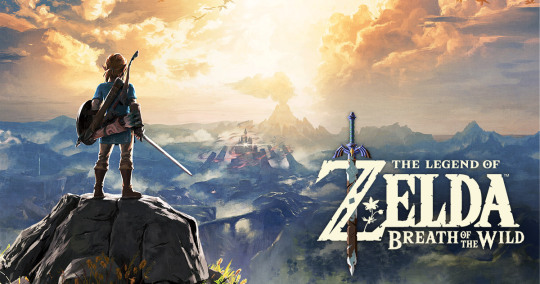
Full disclosure: this is the only Zelda game I finished. I’ve also played Ocarina of Time, Link’s Awakening, and the first two NES games, but never finished them.
The Zelda series is long, storied, and with very few exceptions, the games have always been stellar. The formula established in OoT has, however, grown to become a little stale: “go to this dungeon and get this gadget so you can go to this other dungeon and get another gadget, rinse, repeat until Ganon is dead”. The series stood to benefit from a breath of fresh air, and with Skyrim still somewhat fresh in people’s minds, a change of direction to a more open-ended sandbox game has proven to be just the thing Zelda needed.
The Legend of Zelda: Breath of the Wild represents not only a new direction for the Zelda series, but also a love letter to what made the original NES titles so great. Taking place hundreds of years after an evil force known as the Calamity Ganon ravaged Hyrule, players once more take on the role of Link as they re-awaken with no memory of anything that transpired before. With only Zelda’s voice to guide you, you must embark on a journey to defeat Ganon once more, and piece together your missing past.

From the moment the player steps out of the cave they awaken in, a wide panoramic view of Hyrule introduces you to the post-apocalyptic Hyrule, and it looks absolutely gorgeous, like something out of a Studio Ghibli film. In the centuries since Ganon ran roughshod over Hyrule, nature has reclaimed the land, and the vast majority of the world is covered in lush, verdant forests.
One of the many ways BotW pays homage to the NES Zelda games is the fact that, starting off, it’s hard as hell. You begin the game with only the ragged clothes on your back, and you must scavenge for anything that can be used to defend yourself against the monsters that roam the land. Your first weapon will be little more than a common tree branch, and from there, you’ll have to make do with the makeshift weapons and shields that the common monsters employ. You’ll always have to keep your eyes peeled for weapons, since every weapon and shield you pick up will eventually break from overuse. Higher-quality weapons hold up better than the clubs and chunks of wood Moblins use, but you’ll need to be wary of their conditions.
Thankfully, even if you break every weapon in your inventory, you will never be completely defenseless. Always at your side is a Shiekah Slate, an ancient handheld magical computer that can be used to create bombs. Throughout the early parts of the game, you’ll also acquire the ability to use your Slate to create blocks of ice to traverse across water, manipulate metallic objects via magnetism, and even freeze objects and enemies in place.
The Shiekah Slate represents one of the major deviations in the Zelda series’ settings, as this Hyrule has prominent magical technology scattered throughout. Most of the technology has been lost after the calamity that befell it, but one prominent feature that will plague you in your journey is a series of robotic monsters known as “Guardians”, powerful machines that you would do well to avoid early on, as they can kill you very quickly.

Another throwback to classic Zelda, especially the first game, is the fact that once you obtain the paraglider and leave the tutorial area, the entire game world becomes open to you. Those mountains in the distance? You can scale them! That desert to the west? You can walk there! If you want to make a bee-line for the final boss, you can do that too! (You’ll likely die horribly, but you have the option). You are given a vague direction to go into and a slew of story quests that will put you on the path to uncovering Link’s missing past, but you can ignore these and go your own way, if that is what you desire.
However, perhaps as formidable a foe as the monsters in Hyrule is Hyrule itself. You will need to pay heed to the environment around you and the local weather to survive. Fighting enemies on a cliff? Watch your step: if the monster gets a solid blow on you, it’s a long way down. If it rains, you’ll have a harder time climbing up slick surfaces, but the rain can muffle your footprints and let you kill enemies stealthily. Is there a thunderstorm in the area? Better drop off any metallic equipment you have, unless you wanna become a human lightning rod! And of course, you’ll need to be mindful of how you dress when travelling to the deserts or the mountain tops; without the proper garb, you’ll freeze or fry to death. If you have a fire-based weapon or a torch when travelling to cold environs, though, you can get around the need for insulated clothing.
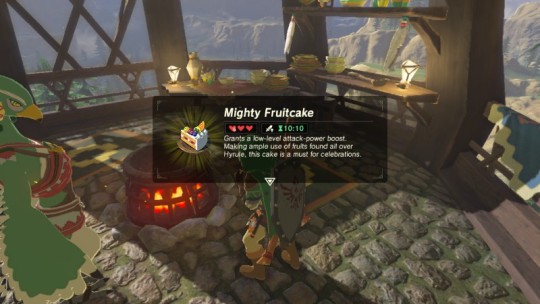
Also key to your survival is cooking meals and brewing potions. Throughout the game, you’ll come across a variety of ingredients that can be used in cooking, from fruits and vegetables to body parts of monsters. Throwing these parts onto a cooking pot will allow you to cook them, with the interactions between different ingredients creating foods and potions with a wide variety of effects, such as adding spices to meat to make a meal that can keep you warm, or brewing a potion with a certain species of frog that will let you run more quickly. Finding different ingredients and experimenting with cooking can prove to be quite the time sink.
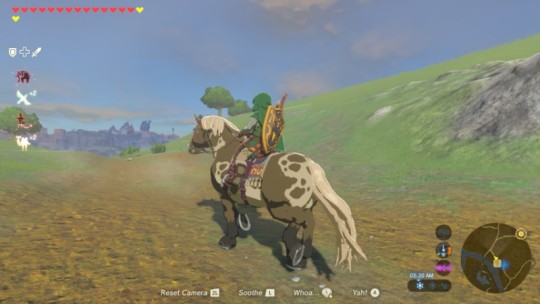
There is no shortage of ways to get around Hyrule; as previously mentioned, you get a paraglider early in the game that will let you soar through the air. Horses can also be found, tamed, and mounted, providing a quick means of transport across the realm.
Of course, no Zelda game is complete without dungeons, and BotW has no shortage of them. How they play out, however, has changed: previous Zelda games have a slew of elaborate dungeons to explore, but the dungeons in BotW are shorter and overall easier. These quests are divided into two categories; Shrines, small dungeons with simplistic puzzles that reward you with items that can be exchanged for increased health and stamina; and the Divine Beasts, four larger dungeons with more elaborate puzzles that end in a boss fight. Long-time Zelda fans may miss the original style of dungeon, but the ones present in BotW are quite fun to take on.

And of course, no Zelda game is complete without combat. While there is a relatively small selection of enemies to contend with in BotW, the ones you come across with are actually fairly smart, so you will need to outwit them rather than fight with brute force, especially since your weapons and shields have limited durability. Well-timed dodges and shield blocks can help you win many encounters, but the environment also provides a variety of ways to creatively dispatch your foes. Some enemy camps may have explosive barrels nearby which you can set off with a well-placed arrow or a bomb. Most monsters can’t swim, so if you can knock them into a nearby river or lake, you can take them out easily. If there’s any metallic objects nearby, you can use Magnesis to move it and beat enemies around, or even to yank away any weapons they have if they are made of metal.
One of the things I truly love about BotW is the feeling that every time I play, I discover something new. Hyrule is teeming in secrets, easter eggs, and little hidden things that are a joy to uncover. One thing I loved finding was the fact that dogs in towns can be fed meat, and if you feed them enough, they’ll dig up a hidden item for you. Using giant leaves to blow winds can also enable me to use primative boats to sail down rivers. And, of course, there’s the interesting little things you can do by taking advantage of the game’s physics engine, like setting up catapults.
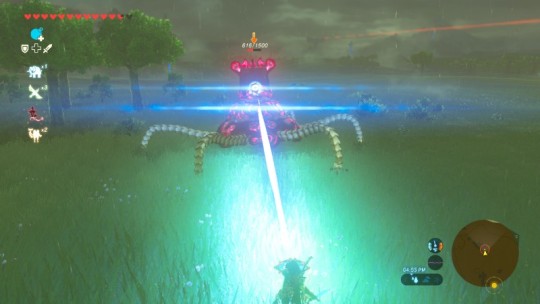
This game was released on both Wii U and the Nintendo Switch. Typically, I’m weary of games released on previous generation systems when released on multiple consoles, but thankfully, BotW was developed originally for the Wii U. I’m pleased to say that the Wii U version of the game holds up very well; even if the graphics don’t look quite as nice, they are still very beautiful, and lag and framerate drops are not very common.
I cannot recommend this game enough. Even if you’re not a Zelda fan, Breath of the Wild is an excellent game to introduce you to the series, or simply to play by itself as a fun and immersive sandbox adventure.
3 notes
·
View notes
Text
Sega Dreamcast
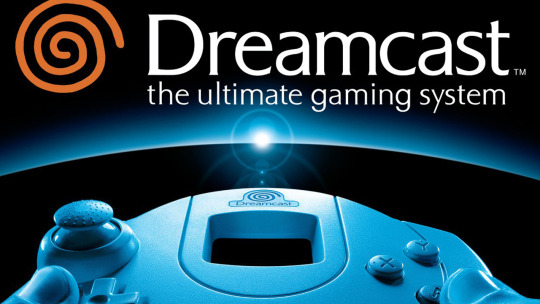
I hated middle school. There’s a whole swath of memories I’d rather do without as far as the years 1999 through 2002 are concerned. There is, however, one memory I hold near and dear to my heart during this time frame. After reading about it in magazines and being really excited for it, my mother took me to Toys’R’Us one evening to get me a Sega Dreamcast. We brought that puppy home with a copy of Sonic Adventure, hooked it up, fired it up, and took it all in. As the opening cinematic played on my TV, Mum said “It’s like playing a movie!”
Boy, if we only knew what games would go on to look like now.
The Dreamcast was, and to this day remains, my all time favorite console. It’s the swan song of a company that was perhaps a bit too ambitious for its own good, a marvel of gaming technology many years ahead of its time, and home to some of the best and most unique games to ever come out.
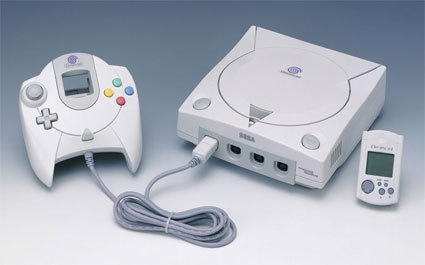
At the time of its release, the Dreamcast was the most graphically powerful console on the market. Sony’s Playstation boasted 32-bit graphics, and the Nintendo 64 had double that, at -wait for it- 64 bits. Dreamcast had double of that: 128 bits of beautiful graphics, thanks to the GD-ROM, a proprietary disc format born from squeezing every bit of memory out of a regular old CD as was physically possible, before DVDs and Blu-Ray became as ubiquitous as they are today.
Even the method of memory storage was unlike its competitors; the standard memory card for the Dreamcast was the Visual Memory Unit (VMU), a cross between a memory card and a Gameboy that let you manage data and download minigames to extend the functionality of many games. The only other thing like it that I can think of being made is Sony’s Pocketstation, and that never saw the light of day outside of Japan. You would not believe the number of button-cell batteries I burned through caring for Chao on the go.
Of course, all of the fancy tech and cool gadgets wouldn’t amount to much if the games on offer weren’t fun at all. Tiger’s Game.Com bragged of being a versatily console and handheld device, but the games for it all stank like a fragrant dog poop laying on the sidewalk on a hot Floridian summer day. Thankfully, fun games were something the Dreamcast had no shortage of, even in the brief few years that it was on the market, a slew of which I’d like to bring attention to.
Sonic Adventure 1 & 2
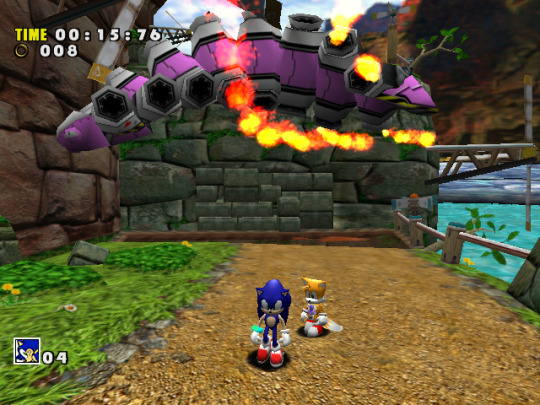
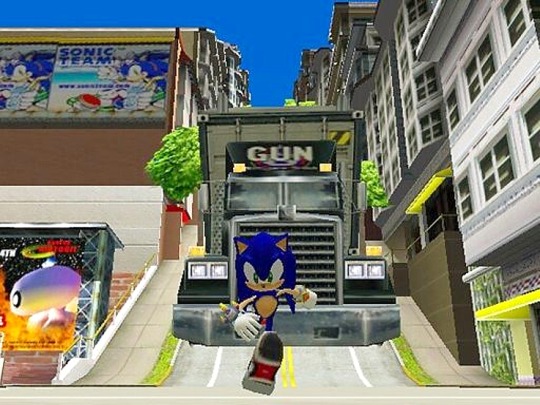
Maybe they haven’t aged as well as I’d like to think, but DAYUM if these weren’t some fun games back in the day. Sonic has always struggled with 3D, but the first attempts at true 3D Sonic games remain quite novel. The first Sonic Adventure had different play styles for each character, some of which were great (Sonic and Gamma, for me at least), others...not so much (the less said about Big, the better), in addition to, for its time, an intricate plot with each character’s story intertwining and playing out differently depending on which character you’re playing as.
Sonic Adventure 2, meanwhile, streamlined the gameplay and improved upon some of the first game’s flaws, cutting out the non-platforming related stages (aside from the treasure hunting stages, which are a touch better than in the first game). It’s story was also very compelling, being one of the darkest storylines in the entire series; government conspiracies, weapons of mass destruction, fucking murder! Maybe that’s not everyone’s cup of tea, but I think we can all agree that SA2 handled “dark and gritty” a lot better than Shadow the Hedgehog’s stand-alone game.
Both games also featured a mini-game that could prove to be just as addicting, if not more so, than the games proper: Chao Gardens. Chao were little, adorable water monsters that players could raise like virtual pets, their popularity likely owed in part to the ubiquity of other virtual pets like Tamagotchi near the end of the millennium, as well as how easy-going and casual raising a Chao was compared to a Digi-Pet that would not wait for you to clean its shit up: you can enter and leave Chao Gardens freely, and you wouldn’t have to worry of your Chao dying of neglect in your absence. There’s also very deep mechanics at work for raising Chao, with their growth and evolution depending heavily on how well you raise them, what animals you give them, and what fruits you feed them, all so you can have them participate in races. The aforementioned VMU also expanded Chao functionality considerably, letting you raise them anywhere you wanted.
Shenmue
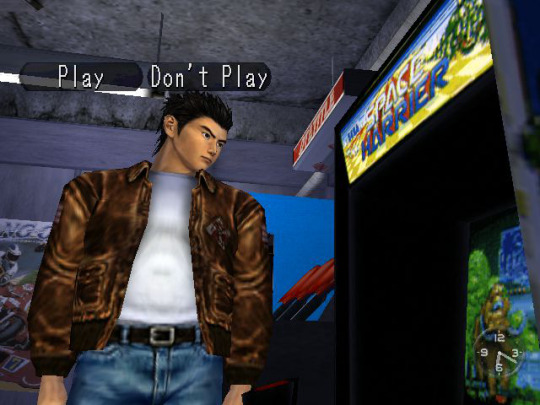
My relationship with Shenmue, these days, is very much that of a love-hate relationship. On the one hand, Shenmue popularized two aspects of gaming today that I loathe; Quick-Time Events, and over-blown game budgets (this game would’ve had to be bought by every DC owner TWICE before it could break even). On the other hand, there’s no denying that this game was a labor of love by Yu Suzuki. The attention to detail in Ryo Hazuki’s hometown of Yokosuka is staggering. Everything you can imagine can be interacted with, down to the last dresser drawer in Ryo’s house. Every resident of Yokosuka was unique from the others and had their own behaviors that they would go through, unlike every other NPC in the town, or other games for that matter. The story may be a tad formulaic, and most of the voice work left something to be desired, but the world of Shenmue was one that was very fun to explore.
Plus, this game introduced me to Space Harrier. If that’s not a good thing, you tell me what is.
Jet Set Radio
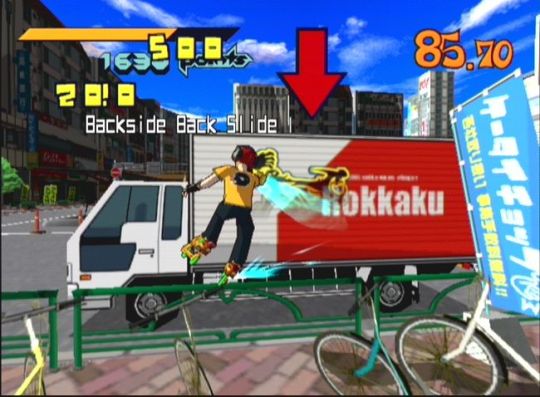
I had to convince my mother this game wouldn’t turn me into a graffiti-painting delinquent. It was a hard sell, but it paid off, and boy am I glad it did.
Jet Set Radio is very much unlike other games, then and today even. This was the game that helped to popularize cel-shaded graphics; the thick black outlines around the character models made this game look like an anime come to life, and eventually paved the way for the wicked-awesome graphics we see today from Arc System Works with Guilty Gear XRD and Dragonball FighterZ. The idea of playing a roller-blading hooligan throwing tags around the city and evading the police was also unique, and kept players on their toes as techno music accompanies their shenanigans. The game was a bit on the short side, but was challenging and fun enough that multiple playthroughs were warranted.
Making my own graffiti tags was also quite the timesink.
Phantasy Star Online

I may be a late bloomer to the Phantasy Star series, but it has become one very dear to me for helping me meet some of my closest friends (Hi, Tara!).
Phantasy Star was a series of JRPGs by Sega meant to compete with other big franchises like Final Fantasy and Dragon Quest. The original PSO, on the other hand, is an online multiplayer dungeon crawler that would change the course of the series from that point forward. As interstellar colonists investigating mysterious phenomena on an alien planet, players would delve into unique locals with characters they would create themselves to slay monsters, collect valuable items, and unravel the mysteries of the planet Ragol.
The original PSO is also very notable for its attempt to break the language barrier with a unique conversation system. While good ol’ fashioned keyboards remained in vogue, players also had the option of constructing sentences to transmit to other players in the area or party in those players’ native languages. Using this system, you could send a message saying “Help! This dragon is too powerful!”, and your friend in Japan would read it as “助けて!この龍は強すぎる!” It may not have seen much use, since players are more likely to congregate and play with those that can speak a common language fluently, but it was very kind of Sega to provide the option.
One thing that gets me straight in the feels is something from the original beta trailer for this game: “The world of Phantasy Star Online lasts for an eternity!” It is not uncommon for trailers and developers to hype games up with hyperbole (just ask Peter Molyneaux), but this is a statement that has held true for PSO! Even after the last official server for the last iteration of PSO shut down in 2008, private servers continue to run the game to this day, ensuring that the world of PSO truly remains eternal. Even with a proper sequel Phantasy Star Online 2 proving to be a pop culture staple in Japan, the original PSO remains one of the most beloved and enduring MMOs in history.
Skies of Arcadia
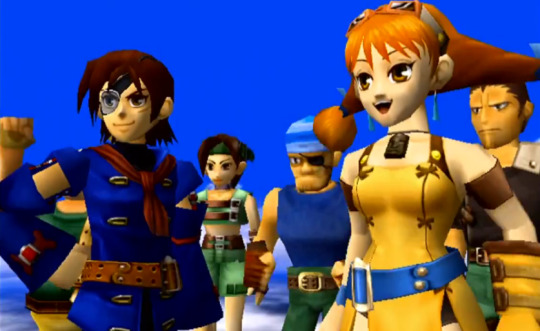
I’ve got friends who would skin my hide and leave me to hang like the Predator if I didn’t mention this.
Just about every console since the NES has a JRPG, and the Dreamcast is no exception. While Phantasy Star shifted towards MMO territory, those hoping for a sweeping single-player adventure still had Skies of Arcadia. As the daring sky pirate Vyse and his motley crew of adventurers, players fought to stop an evil empire from awakening an ancient evil while flying across a world of floating continents in a kickass airship. This game is among the most challenging JRPGs in the genre; a clever mind and strategic acumen are needed to survive battles with other pirates, monsters, and rival airships. The world of the game is also incredibly beautiful; I personally think it has much in common with Castle in the Sky, my favorite Hayao Miyazaki film. The soundtrack compliments the game incredibly, and is a joy to listen to by itself.
---
There are plenty of other games that made the Dreamcast incredible, but this article is long enough as it is, so I’ll have to give those games their proper due later. Suffice to say, though, the Dreamcast is a historical console that remains one of the most beloved in the history of the medium, not only by myself, but by hundreds of thousands of gamers the world over. It may have only been on the market for a few years, but it is said that the brightest stars are the ones that burn out the quickest.
And make no mistake, the Dreamcast is one of the brightest stars there ever was.
234 notes
·
View notes
Text
Xenoblade Chronicles X

(As per usual, there may be some story spoilers. I’ll keep them to a minimum, but consider this your official spoiler alert)
Time has not been very kind to the Wii U, admittedly. It was a console that held great promise when it was released, and it did fairly well early in its run; but in the five years its been out, it’s been largely surpassed by its competitors. In many ways, it is not unlike the Sega Dreamcast (a console for which I have nothing but undying love, but I’ll ramble about it some other time).
Which is a damn shame, because many of the games released on the Wii U are spectacular. Smash Bros. is a given, and Splatoon was a breakout hit that took shooters in an exciting new direction.
One game that’s very near and dear to me, as a fan of sandbox games, science fiction, and giant robots, is Xenoblade Chronicles X, the spiritual successor to one of the best JRPGs of the original Wii.

It is the year 2054, and Earth has gone to shit (moreso than usual): our little ball of mud in the interstellar boondocks has the misfortune of being caught in the crossfire between two alien armies, forcing humanity to flee into the stars before the planet is reduced to cosmic dust. Sadly, one of the alien armies decides to chase after the ark ships, causing one of them, the White Whale, to crashland on a nearby planet called Mira.

It is two months since when you, our hero, are found by a young woman named Elma. With her help, she guides you back to the colony humanity has set up on Mira: New Los Angeles.

Not long after, your are pressed into service for BLADE (Builders of a Legacy After the Destruction of Earth), NLA’s military organization. In addition to building NLA and protecting the colony and its people, BLADE’s chief directive is to seek out a chunk of the White Whale that broke off during its crash landing onto Mira; the Lifehold Core, which contains many humans still trapped in stasis during the journey through space. You and your new friends need to find it, and fast: you’re not the only visitors to Mira, and not every xeno you cross paths with is a big fan of humanity...
Mira is one of the biggest, widest, and most open worlds in any sandbox game of this generation, consisting of a wide variety of locales and biomes, from the wide planes and alien mountains of Primordia...

...to the deserts and ruins of Obllivia...

...to the bio-luminescent jungles of Noctilum.

I’m particularly taken with the region of Sylvalum, with its snowy-looking spore-covered lowlands and crystal spires.

Everything that you see in Mira, from the oceans to the tallest mountains and even floating landmasses, can be reached. You’re fairly limited to where you can go at first, though: you can sprint for as long as you want, jump high, and survive falls of any height without any ill effect, but aside from some clever hopping up some mountains, you won’t be able to reach every single point on the map. Not yet, anyway: as you progress through the game, you’ll get the best means to travel through Mira: a Skell.

Skells are giant robots that are used by elite BLADEs for reconnaissance and combat. You won’t be able to get one right from the start, however: you’ll have to get about halfway through the game before you earn yours. Once you do, however, you’ll be able to move faster and leap higher than you ever could on foot. Later on, when you unlock flight packs for Skells, the entire world opens up to you: you’ll be able to go anywhere you want, with the only limitation being your Skell’s fuel.
Mira is not the most friendly of planets, however: even without the dangers of alien armies trying to drive humanity to extinction, the planet is teeming with all manner of indigenous species, most of which are bigger than you and will eat you for breakfast if you’re not careful. You will need to defend yourself against these dangers.

The combat engine of XBX is an evolution of the one introduces in the original Xenoblade Chronicles and plays out much like a refined version of combat engines in MMORPGs such as Final Fantasy XIV. You launch attacks on enemies automatically when you are within your weapons’ range, but you also have access to various fighting Arts that have different effects, from launching special attacks to drawing aggro, debuffing enemies, healing and buffing allies, and Auras that grant temporary passive benefits.
There are a total of ten classes to choose from for your character, each specializing in different aspects of combat, including the tanky Striker, the nimble hard-hitting Commando, and the supportive Enforcer, plus offshoots of those classes. Any class that you completely master will grant you the ability to use the signature weapons and corresponding Arts of that class with any other class of your choosing, so you have the freedom to mix and match weapons, Arts, and classes to make your ideal fighting build.
Skells are also capable of fighting, and boy-howdy do they pack a punch. Once you unlock your Skell, you can stomp on many enemies you’ve encountered up to that point (sometimes literally!). Skells are pricey, but can be customized to carry a veritable arsenal of weapons. When it comes to common enemies, Skells can make combat easy to the point of triviality, but they are a must-have against some of the toughest beasts and bosses the game has to offer.

The game’s main story is fairly average, but enjoyable. Unfortunately, it also brings one of the biggest downsides to this game: story missions have rather strict unlock requirements which make for some of the most obnoxious examples of gameplay padding. It’s tolerable for the most part, though, since the game is very fun anyway.
In addition to the main story, there are also Affinity Missions that build upon the world and the characters that inhabit it, and Heart-to-Heart scenes that reveal more about your brothers and sisters in arms.
There is also a multiplayer component to the game, but it is largely asynchronus: as BLADEs, each player mainly goes through the singleplayer game, broadcasting their achievements and messages via Miiverse. Players have the option of hiring out other player’s characters in their game for a couple of hours. There are also co-op missions, but I’ve never had a chance to try these.

I actually had this game at launch, but lost my copy during the move to my new house. I managed to snag a new copy for very cheap from Gamestop when it went on clearance, though. If you have a Wii U and love open world RPGs, I highly recommend getting this game.
1 note
·
View note
Text
Persona 5
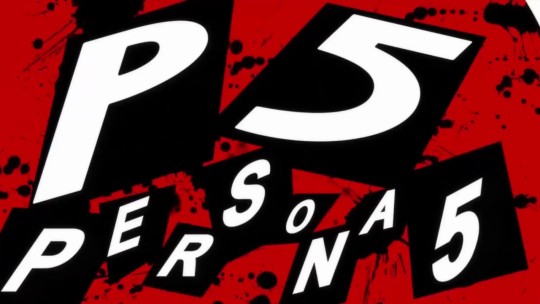
A few things before we proceed: First off, since Atlus doesn’t allow me to record gameplay or take screencaps, I’ll have to pull screenshots off of Google search for illustrative purposes. Second, it’s impossible for me to gush about this game without spoiling a few things. I’ll keep major story spoilers contained to events surrounding the first major story dungeon. Nonetheless, consider this your spoiler warning.
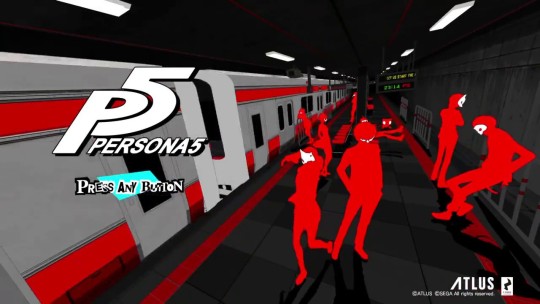
I remember, as a wee lad (or as wee a lad as I can be while attending college), expressing an interest in Shin Megami Tensei, a game series that, at the time, had only recently started to pick up steam in the US. From that lone Facebook message, I discovered that a classmate in my Japanese class had a copy of Persona 3, and since he had beaten the game, decided to lend his copy to me.
I was hooked from the moment I put the disk into my PS2.
It was from there that I built up interest in the SMT series at large, with its themes of conflicting ideologies, the combination of magic and technology, and the deadly ramifications of their abuses. Through it all, however, the Persona subseries has always held a spot in my heart. That goes double for Persona 3, which combined dungeon crawling with life management, and Persona 4, which refined the gameplay of its predecessor to a fine point.
Persona 5 represents further refinement of the foundation laid by the previous titles in the series, including the ones before Persona 3. It doesn’t necessarily seek to re-invent the wheel, but with gameplay as slick as what it offers, combined with a story that resonates with me on a very deep level, it doesn’t even need to!
Even though the gameplay mechanics are the same, P5 differentiates itself from its forebearers right from the beginning.
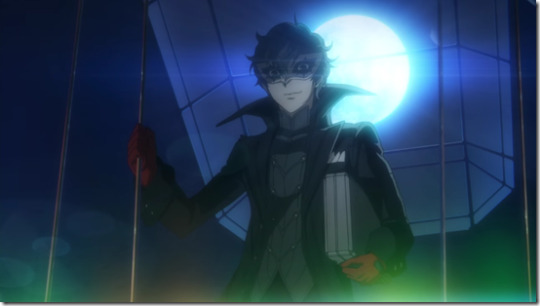
Instead of beginning with your character moving into town, you open the game to the climax of what appears to be a daring heist on a swanky casino, with your character dressed like the world’s classiest burglar. This scene functions as a very basic tutorial for combat and stealth.
Unfortunately, the heist goes south very quickly: just as it seems you’re going to make a clean getaway, the police have you cornered! Nowhere to run, nowhere to hide, you are arrested and taken into custody.
After what may be one of the most ethically dubious interrogations in games (with all the beatings and druggings that entails), you finally name your character as he is forced to sign a confession. Afterwards, a prosecutor arrives to get the full story behind your criminal activities and your bizarre MO, thus setting up the game’s framing device...
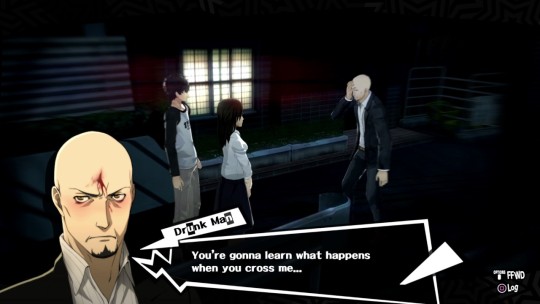
As it turns out, this isn’t your first hoedown at the rodeo: sometime in the spring, you got arrested with an assault charge after trying to help a young woman who was being forced upon by some drunk asshole. You never even put your hands on the jerk, but he is pissed off and influential, so...sucks to be you!
Thankfully, you got off with one year’s probation: so long as you keep out of trouble over the course of the coming school year, you’ll have your criminal record expunged and the stigma of being a juvenile delinquent won’t haunt you til your dying day.
Easier said than done...
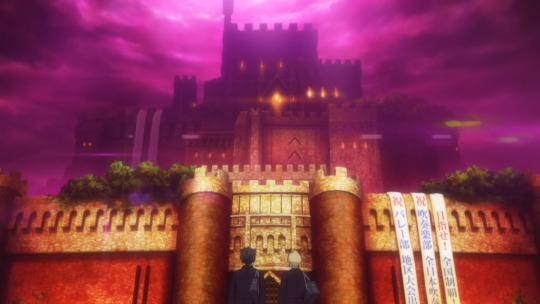
On your way to your first day of school, thanks to a weird app that appeared on your phone, you and a classmate named Ryuji Sakamoto find yourselves very lost, stumbling upon a massive castle. An ill-advised excursion into the castle causes you to run afoul of its king, who bears a striking resemblence to Suguru Kamoshida, your school’s volleyball coach and someone with whom Ryuji has a major beef.
It seems as though you and Ryuji are about to meet with an untimely demise...
And that’s when a voice rings out inside your head, inciting you to rebellion!
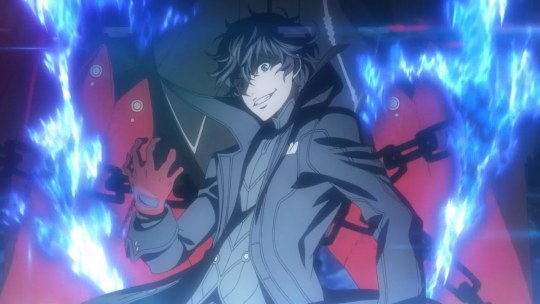
Your Persona, Arsene, awakens. Ryuji awakens his own Persona, as well, and with the manifestations of your inner psyches, along with the help of a cat-like boy named Morgana, you make your escape.
Morgana explains that you had stumbled into the Metaverse, a parellel dimension formed from the human subconscious. That castle you were in? A “Palace”, a manifestation of one’s twisted, corrupt desires. The real world’s Kamoshida, as it turns out, is quite the asshole: he abuses his male students, pervs on his female students, lusts after your classmate Ann Takamaki somethign fierce, and has gotten away with it for ages due to his influence as a former Olympic gold medalist. When he crosses the line by attempting to rape Ann’s best friend, you, Ryuji, Ann, and Morgana make a plan to use the Metaverse and your newfound Persona powers to force Kamoshida to have a change of heart by stealing his “Treasure”, the core of his Palace’s distortions.
Thus, the stage is set for Persona 5, a story that speaks volumes to millennials, a generation disaffected by adults who abuse their power and make life more miserable for those who will later shape the world when they are gone.
A common thread between you and your accomplices, the “Phantom Thieves”, is this disaffection: Ryuji and Ann, as previously mentioned, have a personal quarrel with Kamoshida for his abuse/perversion, while the thief that joins you not long after, the artistic prodigy Yusuke Kitagawa, suffers under the thumb of a mentor who makes a fortune using plagiarized artwork.
The gameplay outside of dungeon crawling takes on the form of a life simulator: during the day, you will need to attend classes, as well as work part time for spending money, study for exams, watch movies, and maintain relationships with your fellow thieves, peers from school, and people around Tokyo. These relationships, called “Confidants”, are an evolution of the “Social Link” system from previous games. Your Confidants, similar to you, are victims of circumstances pushed upon them by those abusing their power: from the back alley doctor Tae Takemi, who is being harassed by the boss of the hospital she worked at; to Munehisa Iwai, an airsoft gun store owner whose dark past is catching up with him; and even your homeroom teacher, Sadayo Kawakami, who has little choice but to work as an in-call maid to make ends meet.
There is incentive to foster these relationships: the higher up you rank a Confidant, the more powerful the Personas of their corresponding arcana you can create. Unlike previous games, there are also benefits outside of Persona-fusing as you rank up each Confidant: Takemi will make more restorative medications and give you discounts, Iwai will customize weapons for you at his shop, and Kawakami will let you slack off during class every so often.
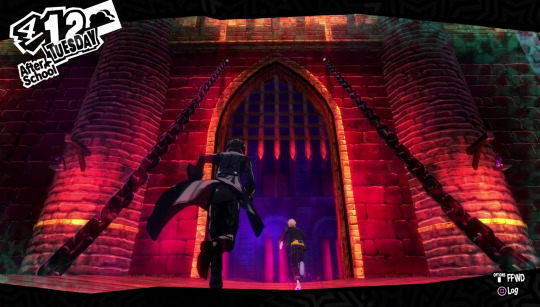
The main meat of the game, of course, is in dungeon crawling, which has been similarly refined in P5. Previous games used randomly generated dungeons, but the story dungeons in this game, referred to as “Palaces”, are hand-crafted instances that have a fixed structure throughout. To keep from being boring, each Palace has a unique theme, puzzles, and light platforming that helps to give them character, as well as resembling the locations you would expect thieves to pull off their capers, such as castles, museums, banks, and the aforementioned casino.
Stealth has been a minor part of previous Persona games, but in P5, it is an important part of Palace raiding: getting spotted by Shadows in a Palace will cause its security level to rise, and if it reaches 100%, you will be booted out automatically, thus wasting time. There is incentive beyond an advantage in battle to getting the drop on Shadows: a successful stealth attack can reduce security and make exploration easier in the long run.
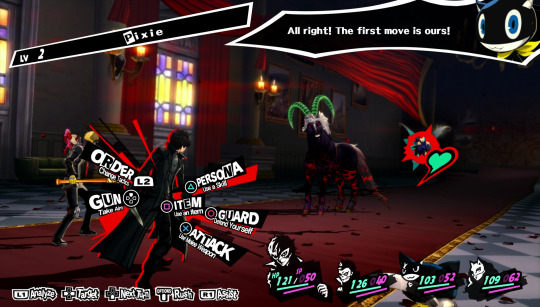
The battle system takes elements from not only the two previous games, but Persona and SMT games before that. As with before, the key to victory lies in exploiting elemental weaknesses in your opponents, thus earning extra turns. Succeeding in knocking down every enemy will give you the opportunity to launch an All-Out Attack, inflicting massive damage on your foes.
However, that’s no longer the only thing that you can do when you’ve incapacitated your enemies: negotiations, a long-standing tradition in SMT and a feature of earlier Persona games, makes a return in P5. When talking to a Shadow, you can extort money and items from them, or convince them to join you as a brand spanking new Persona!
Once you clear a Palace, it no longer becomes accessible. If you need to do some grinding, however, you’re still in luck: there is another facet of the Multiverse, known as “Mementos”, that you can explore. Taking the form of randomly generated dungeons inside a sprawling maze of subway tunnels, Mementos serves as a means to gather new Personas and items, as well as the location from which you can carry out side-quests for EXP and advancement through Confidant plotlines.
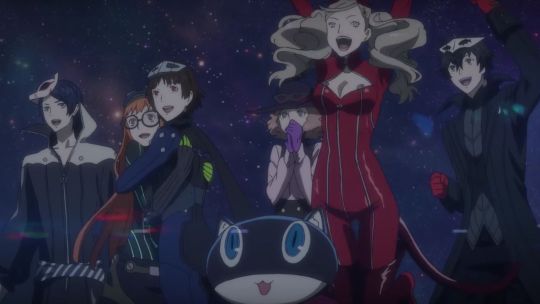
As of this writing, I have not yet beat the game, but have made my way through a very large chunk of it: it is November in game-time, and I cannot say anything more about the story without spoiling anything. If you’re a fan of SMT, dungeon crawlers, and/or life sims; or if you’re a cranky millennial who is pissed off something fierce about the state of the world that you live in, then I very highly recommend Persona 5!
0 notes
Text
Yakuza 0
I’m not going to mince words. I fucking love the Yakuza series. With the exception of Yakuza 3, I have played every game in the series that had made its way to the west (yes, even Dead Souls, I like zombie games, shut up). People like to rag on Sega, saying they’re a shit company because their recent Sonic games are a parade of crap, a sentiment that does have some merit. This is the series I hold up as an example that Sega still has it. I was talking about Yakuza with a good friend of mine, and even though she hasn’t played any of the games, even she recognizes that it’s one of the biggest labors of love in gaming.
(note to self: gotta get TL a Yakuza game sometime in the very near future)
It is thus, with a great deal of joy, that I can say Yakuza 0 is perhaps the best game in the series to date, an exemplar of everything that makes the Yakuza series great.
(A bit of warning beforehand: there may be some minor spoilers for the Yakuza series ahead. I’ll avoid the major spoilers, but nonetheless, proceed with caution.)

The game takes place in late 1988, near the end of a period of Japanese history known as the “Bubble Economy”. After World War II, Japan’s economy was in shambles, but with a bit of help from the US, the Japanese economy made the mother of all economic rebounds and went on to become the second largest industry in the world, overtaking others in engineering and consumer products.
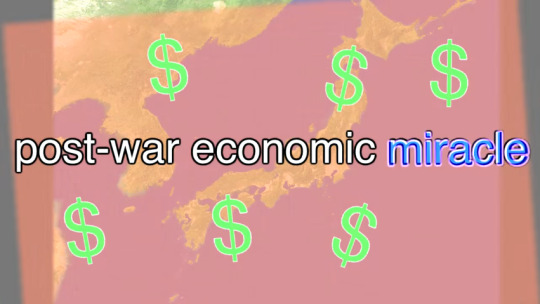
With this economic boom came money. Tons of money. Volumes of money. Japanese citizens had cash to burn as the economic bubble grew to epic proportions. Sadly, the good times would not last: the bubble burst in the 1990′s, and Japan has suffered from a recession that it continues to struggle with to this day.
It is in this time of prosperity that Yakuza 0 begins. Being a prequel, this represents an excellent point for new fans to jump in, as no knowledge of the previous games is necessary (though it enhances the experience, natch).
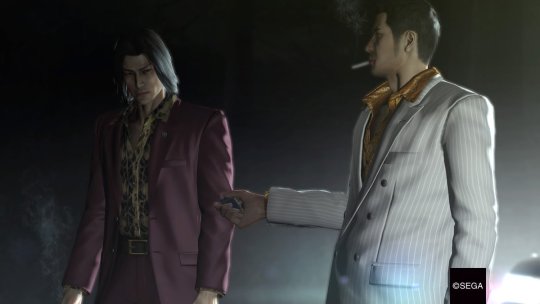
Yakuza 0 is a tale of two cities, and two gangsters. The first, coming out of the Kamurocho district in Tokyo, is series protagonist Kazuma Kiryu, a fresh-faced 20-year-old underling in the Dojima Family, one of the most influential (and infamous) factions in the criminal syndicate known as the Tojo Clan. One cold December night, Kiryu finishes shaking down some poor schmuck in debt to a loan shark, then meets up with his best friend and blood brother Akira Nishikiyama for a night out on the town, drinking and singing karaoke before hitting up a cozy little ramen shop.
The fun times come to an abrupt halt when a news bulletin breaks: there’s been a murder in Kamurocho! What makes this different from the other gang-related violence in the city is the fact that the deceased was the same person Kiryu shook down mere hours earlier! Worse still, the body was found on an empty lot in the center of a redevelopment project that the Tojo Clan has been eyeing for quite a while: a dead body and police investigation keeps them from getting their hands on it, and that makes the leadership in the Tojo Clan very cranky.
Not helping matters is a conspiracy among the top brass in the Tojo Clan to usurp the position of the clan’s captain, held by Kiryu’s sponsor and father-figure Shintaro Kazama. If Kiryu was responsible for the murder, it would reflect poorly on Kazama. As a result, the clan’s lieutenants are gunning to have Kiryu take the fall for the murder he did not commit. It’s a race against time as Kiryu tries desperately to clear his name and keep himself and Kazama out of the Tojo Clan’s crosshairs.

Meanwhile, in Sotenbori, Osaka, we have Goro Majima, a 24-year-old gangster from back before he went off the deep end and became a nutjob. He’s living the dream, managing a successful cabaret and raking in dough like a baker in a neon-lit bakery. It is not his dream that he is living, however, for Sotenbori is actually little more than a gilded cage to Majima.
A few years prior, Majima conspired with his sworn brother Taiga Saejima to take down the leaders of one of the Tojo Clan’s rivals. A Tojo Clan higher-up didn’t take this well, and detained Majima while Saejima took the fall and was sentenced to death row. For his trouble, Majima lost his left eye, was exiled from the Tojo and given over to Osaka’s Omi Alliance, where he was tortured for a year before being released on a heavily-supervised work release program, managing the afformentioned cabaret to make enough money to essentially buy his way back into the Tojo.
Eventually, however, a shortcut presents itself: Majima’s handler is willing to put a good word in for him if he is willing to carry out a little bit of wetwork, an assassination. One life in exchange for a ticket back into the Tojo Clan? How hard can it be?
When he realizes his target is actually a defenseless blind woman, though, he hesitates. Does he have it in him to take her life? Is he prepared to face the consequences for not carrying through with the assassination? Can he find some way out of this quandary with his life, and his sanity?
The stories of the Yakuza series have never been anything less than solid. I can’t really talk about it without spoiling it, but it will tug at your heartstrings and keep you on the edge of your seat.
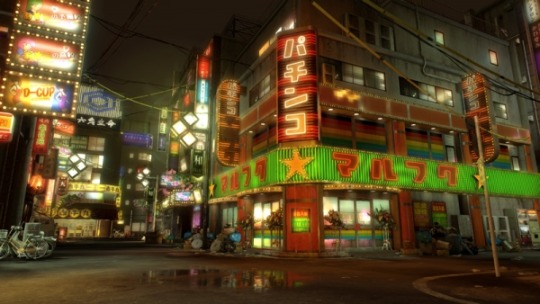

The visuals of Yakuza 0 are a treat, as well: the cities of Kamurocho and Sotenbori look amazing on the PS4, both of them neon-lit playgrounds with a gritty, dingy feel to them. While the graphics may not always be perfect (some textures are a bit blurry and many NPC models look a bit jagged and antiquated), they are never painful to look at. The sound department is no slouch either, with music that is a joy to listen to and voice acting that is always on point.
Of course, a game that looks and sounds good would not be worth a damn if it wasn’t fun to play. Thankfully, Yakuza 0 exemplifies fun.
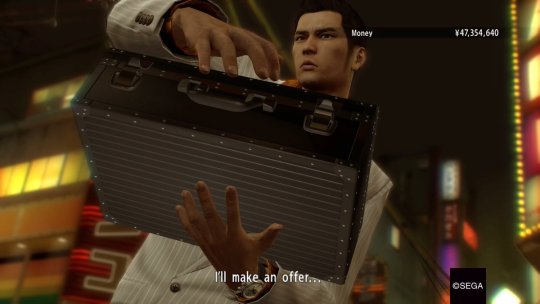

Kamurocho and Sotenbori are brimming with things to do and sidequests to complete. These substories, distinct from the game’s main plot, are always a treat to engage in, featuring bizarre stories and characters that contrast with the campaign’s hard-hitting crime drama. To name a few examples:
-Kiryu meets a yanki band (a mix of punk rock and ‘50s greaser fashion) who are much too mild-mannered, and must teach them how to be hardcore to impress their fans.
-Kiryu gets swept up pretending to be a TV producer after the real producer was chased off by an overbearing director.
-Kiryu volunteers to help a young boy buy a dirty magazine from a vending machine.
-Majima volunteers to play a pretend boyfriend for a young woman who is tired of her father trying to arrange her marriage.
-Majima must infiltrate a Scientology-inspired cult to rescue a woman’s brainwashed daughter.
-Majima has to help a high school student retrieve his pants from a bully, who turns out to be Yakuza 2′s Ryuji Goda back when he was in grade school.
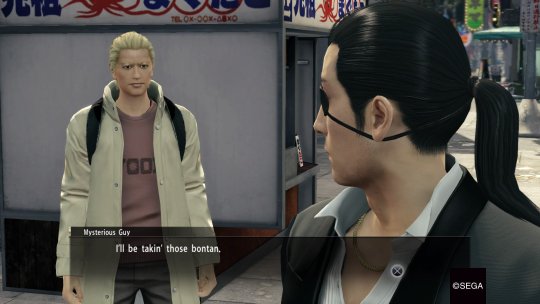
There are dozens more, but all of them are fun to partake in.
Those sidequests, as well as simply walking the mean streets, may lead to getting into a brawl with some unsavory characters, and combat has thankfully always been one of Yakuza’s strongest points. This remains true in Yakuza 0, which features challenging battles against gangsters and thugs. Each character has three fighting styles they can switch between on the fly: Kiryu has a balanced “Brawler” style, a fast-paced “Rush” boxing style, and a slow but powerful “Beast” style that weaponizes anything not bolted to the ground. Meanwhile, Majima has the deadly “Thug” style, a baseball bat-centric “Slugger” style, and an insane multi-hitting super-stylish “Breaker” style (my personal favorite). Each style has its own strengths and weaknesses, but all of them are practical and fun to use. All of them also have their own unique “Heat” moves that are absolutely brutal, but satisfying to pull of.
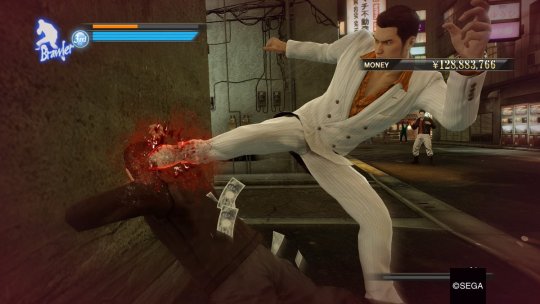



In line with the game’s theme of economic prosperity, enemies practically bleed money when you batter them: it’s not unheard of to rake in at least a cool few hundred Gs in per fight. You’re gonna need that cash, too: there is no experience points or levels in Yakuza 0. Instead, you purchase upgrades for your fighting styles, and they get expensive as you make your way through each skill tree, with the highest upgrades costing hundreds of millions of yen, if not billions.
This, of course, means you’ll need to find ways to make money beyond simply beating it out of street punks. One way is by finding and helping citizens being harassed by bad guys. Helping them out gets you high quality items, some of which you can sell at pawn shops for wads of cash. Another is by challenging Mr. Shakedown, a burly buster who wonders the streets shaking down anyone who crosses him. Losing to him means you will lose all of your cash, but if you can beat him, you’ll earn a metric fuckton of money (including any money you lost to him before).
About halfway through the game, you also get a chance to engage in side businesses to further pad your wallet. Kiryu becomes the leader of a real estate agency, and is tasked with purchasing properties and collecting their profits while hiring managers to maximize their profits and security to ensure business goes smoothly. Majima, meanwhile, becomes the manager of a cabaret club, a mainstay of previous Yakuza games, but not as ubiquitous in the 80s as in later in the series chronology. Here, Majima must train hostesses and keep up with customer demands to make a profit. While Majima’s business venture doesn’t have the raw money output as Kiryu’s, it is more engaging and fun. That’s not to say Kiryu’s real estate business is without merit: there is a fair amount of strategy involved in hiring the right people to maximize profits.
All work and no play makes for dull gangsters, though. Thankfully, this is where another large strength of the Yakuza series comes into play: minigames! There is no shortage of ways to burn your money.

There are arcades in Sotenbori and Kamurocho, and they have classic Sega arcade games on display. My inner 12-year-old reveled at the chance to play Space Harrier again since Shenmue, with OutRun also taking more than its fair share of my money. Completing certain sidequests also unlocks Super Hang-On and Fantasy Zone, so there is variety as far as retro gaming goes.
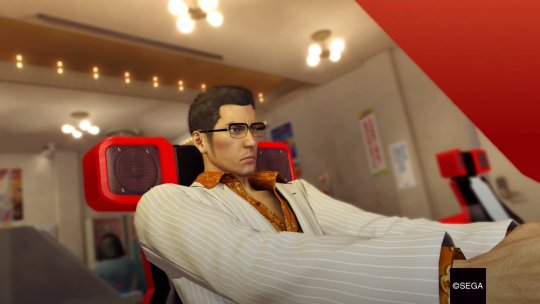

But that’s just the tip of the iceberg. One new attraction for Kiryu is the telephone club, a unique dating service in Japan. The game plays out similar to an arcade shooter, where Kiryu must hold the girl’s attention by aiming at and hitting the proper phrases to increase her affection and ultimately ask her out. It’s a lot harder than it sounds: the correct phrases are often hard to hit, and until you get some practice, you’ll often end up accidentally asking girls about their baby ferrets rather than their best features.
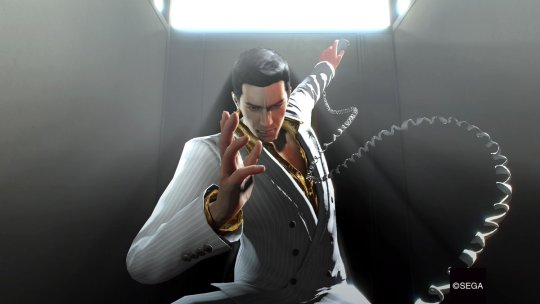
Another unique outfit in Kamurocho is an underground women’s wrestling ring, where you can bet money on the outcome of fights between buxom battlers. The battles play out like rock-paper-scissors, and are high-risk high-reward.
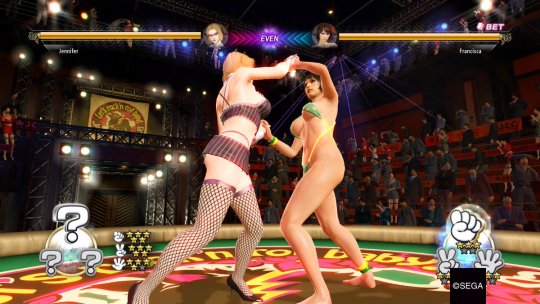
There are also disco clubs, which feature a rhythm/puzzle game where you have to move an avatar on a dance floor before moving them over spaces with a face button on it. Again, not as easy as it sounds, but still very fun, and the music is a treat to listen to.

Finally, among the new attractions is “Pocket Circuit”, a slot car racing tournament wherein you can customize your own little race car and race for prizes and fame. There are tons of parts to use, some purchased from stores, others found in the world.
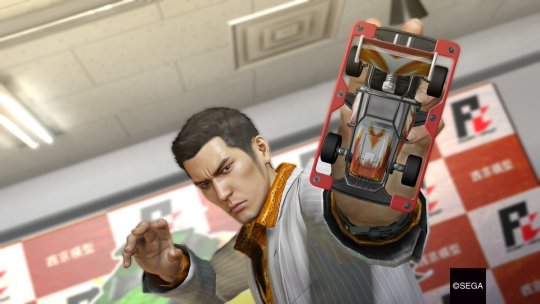
Aside from those, there are many other mainstays of the series that return and are still fun to play: karaoke, gambling, underground fighting tournaments, fishing, darts, pool, and so on. You will never be lacking in ways to amuse yourself.
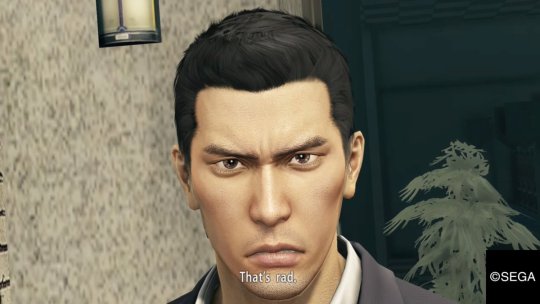
My love of the Yakuza series, and Yakuza 0 in particular, cannot be overstated. I recommend this game to everyone, series veterans and newcomers alike, action game fans, Japanese game fans, and anyone who enjoys good stories, good gameplay, and fun in general.
14 notes
·
View notes
Text
Dragon Quest Builders
I like a good sandbox game from time to time. I’ve been all over Saints Row, GTAV, Fallout 4, and I’m thinking of getting the remake of Skyrim when it comes out. At the same time, however, I like structure. I do my best when I have a general direction to go in: go to this place to start a mission, buy this gun before starting that mission, and so on. This is one of the reasons I’ve lapsed on Minecraft: aside from finding and activating the End Portal, there’s not much in the way of structure. It’s all well and good when I’m palling around with friends and building giant dongs with a beacon making it look like it’s ejaculating a laser, but if I’m playing by myself, I basically find myself wandering around somewhat aimlessly, eventually getting bored and moving on to something else.
In recent years, I’ve also become a fan of Dragon Quest, having picked up the ninth game on the DS. I was mostly drawn by the ability in-game to build a party of custom-made characters (character creators are like crack to me), but the more I played, the more enamoured I became with the world, the nostalgic simplicity of the game, and the character designs by Akira Toriyama (I love DBZ, shut up!).
When I first heard of Dragon Quest Builders, my first thought, as was many others no doubt, was that it was essentially Minecraft with a splash of anime-colored paint. What I found when I dove into it, however, was a game that was greater than the sum of its raw materials.

The game takes place in the realm of Alefgard, the same kingdom that was present in the first three Dragon Quest games (or “Dragon Warrior”, if you were old and cool enough to play them on NES). At the end of the first game, the Hero confronts the wicked Dragonlord, who offers him a place by his side, ruling over half of the world. In the canon of the original trilogy, the Hero tells the Dragonlord “You can royally kisseth mine arse” and beats him like a redheaded stepchild.
Builders, on the other hand, follows a different series of events, where the Hero decided to take up the Dragonlord’s offer and become his co-tyrant. Of course, the Dragonlord being the shithead he is, he kills the Hero, then plunges Alefgard into darkness. In the generations since his reign of terror begins, civilization crumbles apart, and humanity loses their creative spark: the ability to combine raw materials into new objects, the concept of filling in holes in walls with dirt, and the very idea behind the word “build” become a lost art.
This is where you come in: you are the legendary Builder, the one person left in the realm who can create things. The goddess Rubiss tasks you with rebuilding the realm, giving you a Banner of Hope to establish the ruins of the city of Cantlin as a beacon of civilization’s rebirth. In time, people will flock to this banner, and you will need to build rooms for them to sleep in. At first, the only tool at your disposal will be a stick, and you’ll only be able to build simple furniture and tools out of sticks and grass. As you progress, you’ll be able to build new tools to extract new materials, and from there make new things, which can be used to make new tools, and so on and so forth.

With Minecraft’s big strength being complete freedom to go where you want, do what you want, and build what you want, one might think that the structure that comes with a story campaign would be a detriment. Instead, it proves to be a major boon to Builders. It is through completing quests for your villagers that you begin to unlock new recipes and advance through the game, while there is still plenty for you to build and discover on your own. I, myself, wound up unintentionally upgrading a sickroom into an infirmary by adding a couple of extra beds to make room for more patients.
Of course, the Dragonlord isn’t going to take your rebuilding civilization lying down. Throughout the game, you will need to protect your village against monsters, both those that wander a bit too close to your settlement and marauding bands of beasts in instanced battles. Monsters also drop items that can be used in building, so combat plays a sizeable part in the game. It’s not much more complex than in Minecraft: the key to victory still lies in bludgeoning your enemies with whatever instruments of combat you’ve made for yourself. The enemies do tend to be a bit smarter than the zombies and skeletons of Minecraft, though: some may heal themselves, while others will try to charge at you, and others still will bombard you with magic. The enemy types, too, are highly diverse and run the gamot across Dragon Quest’s iconic bestiary, from the diminutive Slime to burly Golems, all the way up to - you guessed it - Dragons.

And if you’re still itching for the chance to build what you want without having to put up with any monster bullshit, you have that option with the unlockable “Terra Incognita”, which provides you with an island that is completely free of hostile monsters, where you can build to your heart’s content. The main continents from the story campaign are also available via portals, so you can go collect materials and explore if you so choose. The big downside to Terra Incognita is that there is no multiplayer: aside from the ability to import other players’ creations, it is a solitary experience. This feels like a big missed opportunity, considering multiplayer has helped to enhance Minecraft greatly. Perhaps if we’re lucky enough to get a sequel...
At the time of this posting, I’m only on the second of four continents in the game’s story, but each chapter is beefy and lengthy enough to keep you engaged. They also have a variety of challenges to complete, though you only learn what they are at the chapter’s conclusion. I didn’t even know there were Dragons on the first continent, but there was a challenge to slay three of them. This provides a good bit of replay value.

The game’s aesthetics are also a major boon for Builders: I’m sorry to say, but as good as Minecraft is, it’s pretty ugly looking. Builders, on the other hand, looks amazing, with bright colors and charming character designs for villagers and monsters alike (thanks, Toriyama!). The blocky voxel-based appearance of the continents also add to a strong old-school vibe for the game: Minecraft’s visuals are evocative of 8-bit games on the NES, which works to Builders’s advantage, considering its pedigree as one of the forerunners of the entire JRPG genre.
If you’re interested in building sandbox games, but Minecraft intimidates you or otherwise puts you off, Dragon Quest Builders is an excellent alternative.
2 notes
·
View notes